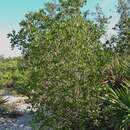Comments
provided by eFloras
Quercus inopina occurs from Orange County, Florida, southwest to Manatee County and south to Martin County. It flowers one to two weeks later than Q . myrtifolia (A. F. Johnson and W. G. Abrahamson 1982).
The leaves of this species often have numerous small black dots on the adaxial surface. These are ascocarps (the sexual fruiting bodies of ascomycete fungi) of the genus Asterina (D. M. Hunt, pers. comm).
Although no hybrids have been formally described, evidence of hybridization of Quercus inopina with Q . hemisphaerica , Q . laevis , and Q . myrtifolia has been reported (D. M. Hunt 1989).
- license
- cc-by-nc-sa-3.0
- copyright
- Missouri Botanical Garden, 4344 Shaw Boulevard, St. Louis, MO, 63110 USA
Description
provided by eFloras
Shrubs , evergreen, to 5 m. Bark gray. Twigs light to dark purplish brown, (1.5-)2-3(-4) mm diam., glabrate to sparsely pubescent, especially at apex. Terminal buds dark purplish brown, ovoid to subconic, 2-6 mm, noticeably 5-angled in cross section, glabrous to tawny strigose on apical 1/3. Leaves: petiole 1.5-8.5 mm, glabrous, occasionally sparsely pubescent. Leaf blade ovate or elliptic to obovate, occasionally spatulate, (25-)45-85 × (15-)25-45 mm, base acute to rounded or cordate, margins entire, strongly revolute, with 1 apical awn, apex obtuse or rounded; surfaces abaxially yellow-scurfy, occasionally somewhat pubescent, rarely glabrous, adaxially distinctly convex, rugose, glabrous or with scattered hairs, especially along midrib and at base. Acorns biennial; cup cup-shaped to bowl-shaped, 6-8 mm high × 10-15 mm wide, covering 1/3-1/2 nut, outer surface puberulent, inner surface half to fully pubescent, scale tips tightly appressed, acute; nut ovoid to broadly ellipsoid, 10-14 × 9-13 mm, glabrate, scar diam. 4.5-8 mm.
- license
- cc-by-nc-sa-3.0
- copyright
- Missouri Botanical Garden, 4344 Shaw Boulevard, St. Louis, MO, 63110 USA
Habitat
provided by eFloras
On deep white "sugar" sands of low sandhill ridges, scrub communities, and flat upland terraces; 0-50m.
- license
- cc-by-nc-sa-3.0
- copyright
- Missouri Botanical Garden, 4344 Shaw Boulevard, St. Louis, MO, 63110 USA
Quercus inopina: Brief Summary
provided by wikipedia EN
Quercus inopina, the sandhill oak, is an uncommon North American species of oak shrub. It has been found only in the state of Florida in the southeastern United States.
It is a branching shrub up to 5 meters (17 feet) in height. The bark is gray, twigs purplish brown. The leaves are broad, up to 85 millimeters (3+3⁄8 inches) long, usually hairless, with no teeth or lobes.
- license
- cc-by-sa-3.0
- copyright
- Wikipedia authors and editors

